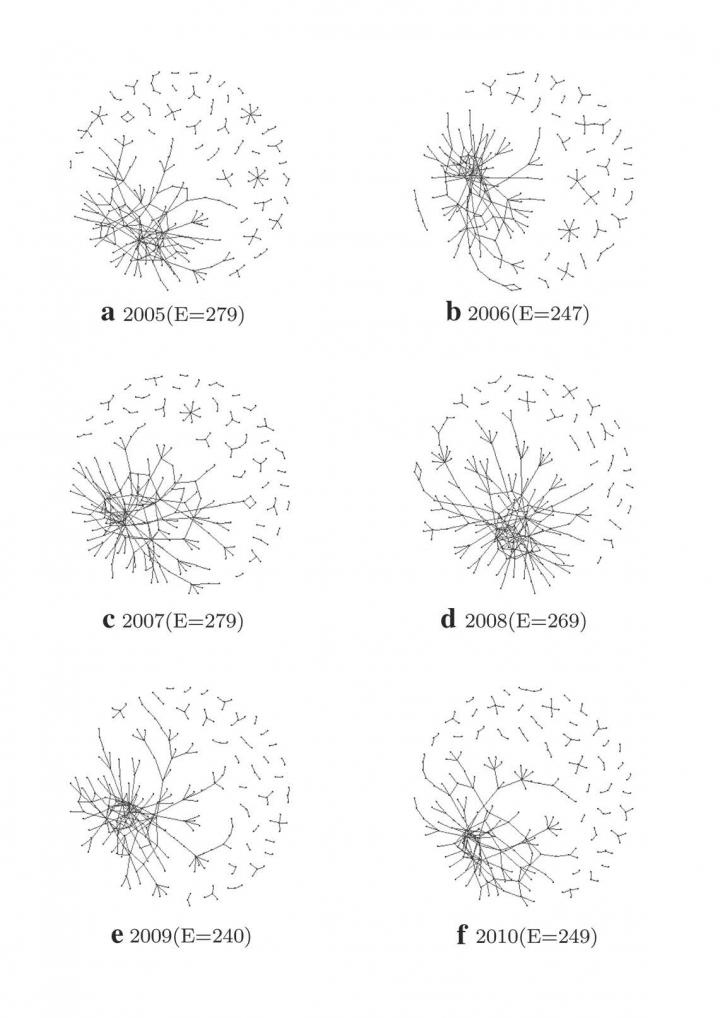
Credit: Copyright© 2020 Springer Nature
Trade friction between industries involved in information communication technology (ICT) have become apparent in recent years. Those trade frictions have striking impact on various industries. Adaptations to these economic fluctuations are necessary for industry and companies in respective regions to survive. However, such phenomena are difficult to analyze because the required datasets cannot be obtained synchronously and spatiotemporally. However, social media and other forms of data collection are making it possible to do more analysis in this field.
Research conducted by PhD candidate Yusaku Ogai and Professor Yoshiyuki Matsumura of Shinshu University et al. aimed to demonstrate how business-to-business (B2B) networks of industries change due to the exchange rate, an indicator of economic fluctuation. The research used datasets from the Japanese textile and apparel industry to show the statistical properties of B2B networks and the changing relationships with the USD/JPY exchange rate.
Some previous studies that focused on complex networks have shown that networks are made of core and peripheral networks. Movie industry networks of creators comprise of core and peripheral networks (Cattani and Ferriani 2008). Studies of Twitter account networks have also shown that the network structures are scale-free (Ikegami et al. 2017) and comprise core and peripheral networks. These behaviors within core and peripheral have also been discussed regarding the adaptiveness of swarms and the process of generating new ideas (Craig 1987). The research by Matsumura Lab builds on these previous studies by adding adaptive behavior in complex networks that comprise of core and peripheral networks in the presence of economic fluctuation. There have been studies into how the exchange rate effects the performance of Japanese companies, but studies based on numerical methods focused on B2B networks itself is new.
The study found that cores of networks are more adaptive to environmental changes in the context of complex systems. However, adaptive behavior alone cannot create new ideas or methods for adjusting to environmental changes. When the most adaptive communities cannot adjust to environmental changes, peripheries can introduce new ideas and methods to an entire system. This is why interactions and networking between core and peripheral are important. In the context of multi-agent systems, reinforcement learning is implemented with algorithms that are epsilon-greedy methods (Sutton 1990). The algorithm for an agent control also comprises the most adaptive attitude and exploratory attitudes.
The first approach examined the statistical properties of power-law in the entire network. These results showed that the entire network are made of a few companies with high degrees of connectivity and many companies with low degrees. The few companies with high degrees are the core networks of international trading companies, and the peripheral networks are domestic companies with fewer connections.
The second approach found correlations by regression analyses using the network indexes and the USD/JPY exchange rate. This method showed that the peripheral networks correlated negatively with the USD/JPY exchange rate and that the core networks correlated positively with the USD/JPY exchange rate. These results not only show economic characteristics of importing and exporting but demonstrate the changing of the B2B networks.
This research elucidated strategies for adaptations of complex systems to trade friction by focusing on the Japanese textile and apparel industry to show how currencies of the global economy affect B2B networks as complex structures. Networking with companies affects the performances of the companies. Peripheral networks such as domestic industries can survive from the most adaptive strategies in the fluctuating economy. The core networks do not have to take the most adaptive strategies under the fluctuating economy. Various ideas and interactions in the networks make industries sustainable under the fluctuating economy.
For future possibilities, the authors will try to demonstrate changing B2B networks using computational models. Research can be conducted using agent based modeling which is a simulation tool for social science. The ultimate goal of the Matsumura Lab is to evaluate the adaptation power of industrial investigating strategies, for example, the adaptation power of swarm strategies of artificial intelligence in the ICT industry.
###
This research was supported by JSPS 17K00302, 24220012, and 23240100.
Media Contact
Hitomi Thompson
[email protected]
Related Journal Article
http://dx.




